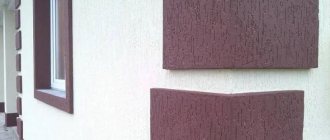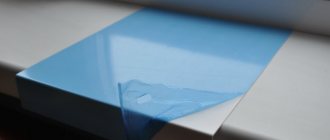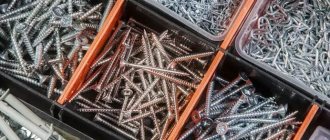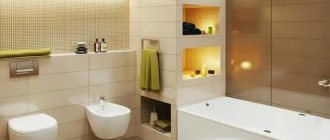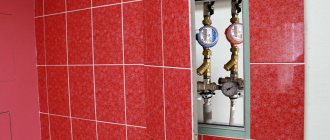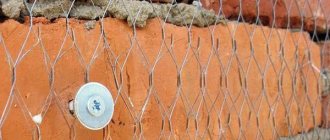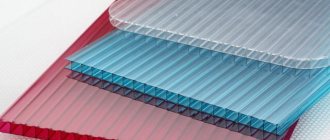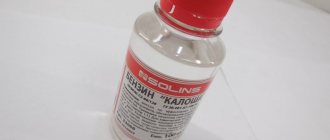Corner spatulas are a useful tool that helps smooth out corners when plastering walls. Those who have at least once plastered know how difficult it can be to make corners even and smooth. And the corner spatula is the first assistant here; with its help, angles of 90 degrees are drawn. But working with corner spatulas has its own subtleties; this tool has its pros and cons. Construction portal Firststroy.ru will talk about the features of working with the tool, discuss the advantages and disadvantages of angle spatulas.
Functions
Today there are a large number of types of tools such as spatulas. Each of them is intended for a specific type of work. The corner spatula, as the name alone suggests, is intended for leveling internal and external corners.
This type is not in particular demand, since it is recommended to use it only when the internal angle is exactly ninety degrees, and for arranging external corner areas, special corners made of aluminum or plastic material are used, giving them the correct shape.
This tool is characterized by thickness, increased strength and a special shape. In work it is used for plastering and filling surfaces.
Types of corner spatulas
There are two types of corner trowels on sale: internal and external. The difference between them lies in the method and purpose of use, and this is achieved by attaching the handle. The internal spatula has a handle attached from the inside, which allows it to smooth out internal corners of different sizes.
Trowel for internal corners
External trowels have a similar design, but their handle is fixed from the outside, which makes it possible to conveniently finish corners of walls, slopes, and arches of geometrically correct shape. Stores also sell tools with large “wings” - they are used to level wide corners and building facades. Most spatulas are made of metal (stainless steel), plastic options are less common.
External corner spatula
Design Features
What does a corner spatula look like? Although the tool for finishing corners is still called a spatula, this is not entirely correct. In fact, this is a real trowel, which has three main elements - a handle, a working surface and a jumper connecting them. The blade is made of durable steel material, bent at a right angle in the center.
The tool we are considering is used only for leveling corners. It is practically not used for external corner surfaces, and this is already considered an unspoken rule. The handle on this option is attached to the outer part of the spatula.
What does an angle spatula look like?
There is a second option - an internal corner spatula. The use of such a tool is advisable on facade areas and indoors, because with its help, angles are perfectly aligned not only at ninety degrees, but also in one precise plane, due to which a single space is created in the corner. In this group of tools, the handle is attached inside the corner.
There is another type of corner tools. If you look at them from the outside, the spatulas look like wings. They prefer to use them to trim wide rectangular corners.
Types of trowels (description and their purpose)
There are a large number of different trowels on the construction market, for this reason it is difficult for a beginner to understand which option should be used for which purpose. The ability to work depends on how the trowel looks and its technical characteristics.
There are a large number of different trowels on the construction market.
Concrete trowel
The concrete trowel is distinguished by its rounded tip, the plate is triangular, and can be 120-180 mm in length. Using a trowel, you can stir the composition and distribute it evenly over the screed.
Often, when preparing a concrete composition, concrete mixers are used, and a trowel makes it possible to remove excess from the walls of the mixer. The device is distinguished by its massive appearance, as well as the smoothness of the plate made of stainless steel.
In the case of aerated concrete, it is necessary to use a trowel with a bucket whose edges are serrated. Allows you to collect the required amount of composition, apply and create a relief base.
Using a trowel, you can stir the composition and distribute it evenly over the screed.
Mason's trowel
This type is considered standard for laying material. A mason's trowel looks like this:
- Triangle in shape;
- Corners are rounded;
- The neck is not folded at a 90 degree angle;
- Dimensions: 120-180 mm.
Sometimes craftsmen can interchange the option for a concrete worker and a mason, but it is still recommended to use a specialized trowel for each type of work. The handles are also molded, which can be extremely uncomfortable during various jobs.
It is recommended to use a specialized trowel for each type of work.
Tiler's trowel
The tiler's trowel is distinguished by a variety of plate sizes, the maximum size reaches 17.4 cm. They are made in the shape of a drop, with a rounded tip. For jointing during finishing, the use of specialized types is required, but it is possible to leave the choice on a universal model, which will be used when laying tiles and working with gaps.
A trowel is used to apply the working composition onto the tile material, creating a distribution over the surface of the solution is carried out with a comb. For good adhesion to the composition, the material for the trowel is chosen to be rough.
Serves as a trowel for spreading the working composition onto the tile material.
Trowel for finishing work
The finisher's trowel is distinguished by its trapezoidal shape, the corners remain sharp. It makes it possible to conveniently pick up and throw the plaster mixture onto the surface. It is required that the working part be smooth, then the composition will fly off onto the base without any problems. It will not be possible to level the layer with a tool.
It makes it possible to conveniently pick up and throw the plaster mixture onto the surface.
Plastering trowel
The trowel for plaster is created in the shape of a wide drop, but the tip is pointed. The shape allows you to level the layer along the base; a model is selected for working with conventional plaster, as well as for Venetian plaster.
For textured types of plaster mixtures, it is advisable to choose special spatulas.
Special spatulas have made the use of trowels unpopular, but they are distinguished by their wider shape, due to which repairs can be completed faster.
For primary plastering, a different type of option is chosen; it is similar to a regular ladle, the neck is small. The handle is attached almost to the base; with the help of such a bucket you can throw in a lot of liquid solution.
The shape allows you to level the layer along the base; a model is selected for working with conventional plaster, as well as for Venetian plaster.
Trowel
For decorative compositions, a notched trowel is more convenient, but a steel trowel is better for creating smooth layers. The grout type is distinguished by a rectangular base, the handle is located in the middle. Due to this feature, it is easy to level the layer.
Grouting requires the creation of perfect smoothness, and compaction of the layer is also achieved. The type is suitable for working with plaster mixtures that must be smooth, like “Venetian”, to create the desired gloss.
Serves more for leveling than for throwing the mixture. The size determines what kind of plaster the tool is suitable for, light or heavy. The materials can be plastic, steel or plexiglass.
Grouting requires the creation of perfect smoothness, and compaction of the layer is also achieved.
Trowel with teeth
The difference from the previous trowel is the presence of teeth along the edges. At the same time, the length of the teeth can be different, the maximum size is 8 mm, they are square in shape. This addition allows you to apply adhesives that should be distributed not in a continuous layer, but in strips.
They are classified as specialized tools for tiling work; they can replace spatulas and serve as a method for ironing the base.
This addition allows you to apply adhesives that should be distributed not in a continuous layer, but in strips.
Trowel for jointing
This trowel has a narrow plate, which is made in a long form, with a rounded edge on the nose. Required to fill the space between brick level, stone level and block level, i.e. covers joints in masonry. The long part is used for horizontal areas, and the spout for vertical areas.
They can replace the spatulas used for this work and work with them simply and quickly. The second name of the subspecies of rustication masters.
Required to fill the space between brick level, stone level and block level, i.e. covers joints in masonry.
Trowel for internal corners
Leveling the corners is a difficult step; you need to create the correct angle so that flaws are not noticeable, so you need to apply the solution correctly. Therefore, special trowels are available for sale for working with corner areas.
Internal corners require creating a book-shaped angle on the tool that is 90 degrees. The neck is attached to the outside of the book. This way the finisher can see when there are deviations from a right angle, and add or cut off excess mortar if necessary.
Internal corners require creating a book-shaped angle on the tool that is 90 degrees.
Trowel for external corners
The main difference between the trowel for external corners and the version for internal corners is the location of the neck that holds the handle. In this case, it is fixed inside the book form.
The use of corner trowels is recommended. The tool makes working with corner areas much easier. This is especially important for novice craftsmen who find it difficult to get an even angle due to lack of experience.
There are other highly specialized subtypes of construction trowels on sale. Their use simplifies non-standard stages and makes it possible to carry out repairs at a high level without turning to professionals. Although, of course, one tool cannot replace experience.
The main difference between the trowel for external corners and the version for internal corners is the location of the neck that holds the handle.
Criterias of choice
In order to choose a high-quality and reliable tool for the job, when purchasing it, it is recommended to evaluate certain criteria:
- comfort of the handle. The speed and quality of the work performed will depend on this. The tool should fit easily in the hand and be held firmly, so you should choose models that have a wide but short handle. The type of blades is assessed separately - they should not have defective areas and be smooth;
- The choice of spatula is carried out according to the area of its use. The dimensions of the tool itself and the material used for its manufacture must fully correspond to the type of work that needs to be performed. For example, with a wide spatula a layer of soil mixture is densely applied, but it is absolutely impossible to eliminate unevenness on the base;
- a tool must be of high quality, and in terms of this indicator, stainless steel products are the best. Such fabrics do not leave marks on the surface, are reliable, and have a long service life.
When choosing an angle spatula, pay attention to the material from which it is finished
Sometimes stores offer iron equipment with a special coating. It is not advisable to use it, since traces of rust remain on the finishing layer. They can even show through the wallpaper.
The blade should be flexible. A hard tool may break during work. There are also super flexible specimens that are difficult to apply putty with.
Technology of use
Now let's figure out how to work with an angle spatula. Let's assume that the joints on the walls are “filled up” by 1 cm or more, which is not uncommon in new buildings. In this case, they will have to be re-plastered.
What to do if the walls are plastered normally, but the joints still “failed” a little? In such cases, experienced professionals recommend different ways to solve the problem. For example, it is proposed to use a corner profile or a construction square. But there is another option that does not require serious skills and a lot of time.
For this you will need:
- putty material for finishing work;
- gypsum plaster;
- angular spatula;
- profiles, level, stepladder.
Now let's talk about how to use a corner spatula to level the surface. Let us immediately note that there is nothing complicated about this.
If you used plasterboard sheets during repairs, then with a high degree of probability you have remaining profiles. Only segments are not suitable - only solid elements are needed. If something happens, you will have to purchase them.
Corner spatula - what kind of tool?
Calling this tool a spatula is not entirely correct; in its structure it is a real trowel. And just like in a trowel, all three components are important: the handle, the working surface and the bridge between these two elements. The trowel blade, made of durable steel, is bent in the middle strictly at a right angle. Based on this, the use of such a tool makes sense only in rooms in which the geometry is strictly observed and the angles are exactly 90° . And there are not so many such premises!
Therefore, most builders question the need for such a tool, and it should be noted that in many ways they are right! Modern technology for plastering walls cannot do without the use of perforated corners, which already have a clearly defined angle and facilitate quick finishing of corners. Let's get acquainted with these methods in more detail!
One in the field is not a warrior - a corner spatula and what else?
To work with plaster, you will need the usual tools: a level, a trowel, usually several spatulas of different widths and a trowel, as well as a grater with a rubber sponge for processing the surface covered with gypsum mixture. A corner tool will also come in handy. To mix the solution, we will need a bucket or other convenient container, as well as a construction mixer.
The preparation process also includes the installation of plaster beacons. These are usually produced in two versions - 6 mm and 10 mm thick. In common people they are called “six” and “ten”. In the case of the “six”, its use makes sense when the plaster is applied in a minimal layer, or when the beacons should be gotten rid of after finishing the walls. You should get rid of them whenever you plan to paint the walls or hang wallpaper, since these products are not always made from stainless steel compounds, and rusty stripes may appear from under the paint or wallpaper. Consider all the repairs to be a waste of the famous animal.
If the surface to be plastered is subsequently “hidden” under the tile, then there is no need to remove the beacons, which means you can safely use the “ten”, since it is much easier to work with, it is not so easy to deform, and it is easier to install.
Manufacturers usually take into account that the standard wall height in our area is around two and a half meters, so you can purchase beacons that match. Starting from the corner, the wall should be divided into one and a half meter vertical strips, along the edges of which beacons should be installed. If for some reason your rule is shorter (although this happens very rarely), then focus on its length, because it is for the emphasis of the rule that you install beacons. For convenience, you can attach a level to the rule with adhesive tape so that you don’t have to apply one to the other every time.
What is a trowel - what does it look like?
Trowel is the traditional name for a tool that looks like a plate with a handle. In everyday life you can often hear the second version of the name of the instrument, for many the more familiar trowel, then it becomes clear to many what a trowel is.
The device can be used for various works, including laying brick material, in this case we mean a mason's trowel. Also used for building mortars, for example, for applying plaster mortar, liquid wallpaper adhesive, etc.
But in different cases, a different type of construction trowel is chosen. Tools can differ greatly in appearance, this allows certain work to be carried out more conveniently. But choosing the right option can be complicated, especially for beginners.
But there are common elements for all tool trowels:
- Working plate;
- The neck is necessary to connect the plate to the handle;
- Handle;
- Butt.
Usually the plate has the shape of a triangle, trapezoid or rectangular, the ends can be rounded. The characteristics and dimensions are influenced by the purpose of the product. For reliability and the need to be smooth, the plate is made of stainless steel or galvanized steel.
The neck is required to connect the parts separated from each other: the handle and the plate; bending affects the application process. This serves as an important difference from a spatula.
Such a difference determines the master’s grip on the tool and helps make the construction work for which the tools are intended more convenient. The handle is often made of wood, maybe plastic, the material is usually of a reinforced type.
Making metal handles makes them heavy, so the master will get tired faster, but the strength of the plastering trowel increases.
The butt performs its function by tapping the stone material so that it takes the required location in the masonry structure. Therefore, it is created from reliable materials, it is necessary to check the correctness of its fastening so that it serves for a long time.
The device can be used for various works, including laying brick material, in this case we mean a mason's trowel.
Areas of application
Plastering trowel or another type is used for different materials. Masons use a device to perform masonry work on the following types of foundations:
- Brick;
- Gas block;
- Cinder block;
- Natural stones;
- Foam concrete blocks.
Using a trowel, mortar is applied to the stone materials, and it also serves as a leveler for the layer, and the butt helps to seat the brick in the desired position. Suitable for working with tile material for applying adhesive mortar.
American and English masons prefer similar-shaped trowels, but in Russia and, for example, in Vietnam, a different type.
A plasterer's trowel is required to apply the composition, and leveling is already carried out with a spatula or a rule. When facing work, you can break off excess stone or tile to obtain the desired angle.
A trowel is also used in everyday life; for beekeeping, it serves as a device for removing debris from the bottom of hives. In addition, some craftsmen prefer to remove droplets from the finishing material with a trowel, rather than with a spatula and scraper.
When choosing a device for construction work, it is worth considering the following tips:
- Determine the required purpose in advance;
- It is required to “try on” the model to the master’s hand. Weight, shape of the handle, all these parameters are important, because the work takes a long time and requires comfort so that the execution is of high quality and less exhausting;
- The plate material is important. Stainless steel will last a long time and is smooth, making it easy to apply the solution. Ferrous metal is rougher; for a beginner it is more convenient to use this type in order to have time to apply the correct layer.
The handle is often covered with rubber material, then it does not slip off the hand.
Using a trowel, mortar is applied to stone materials, and it also serves as a layer leveler.
We install beacons - a guide for right angles!
To install beacons, it is recommended to use a gypsum mixture, and not the usual cement-sand mixture. Why gypsum? It hardens quickly and holds the beacons well, and therefore you won’t have to wait long after installing them, almost immediately starting the main body of work. It is best to mix the mortar with a construction mixer, which is adapted to such loads. An electric drill with an appropriate attachment is, of course, also an option, but be prepared for the fact that the tool cannot handle such loads, as you will know thanks to the characteristic smell of burnt plastic.
It’s better to work the old fashioned way, mixing the mixture by hand - it’s slower, but all the tools are intact. To learn how to dilute plaster, read the instructions on the package. But keep in mind that manufacturers usually indicate a slightly smaller amount of water than is actually needed - the mixture may not be as plastic as you would like. Mix small portions, remember that the plaster hardens at a phenomenal speed. It is not worth using hardened material by breaking it again with a trowel - such gypsum loses its properties, it is also called “dead”. You should get a plastic, sticky and soft mass.
We throw a small amount of the mixture onto the intended installation points for the beacons - scoop them up and slap them against the wall, keeping a distance of about 30 cm. Install the corner beacons first, retreating from the corner of 20 centimeters. We apply the beacon to the “cakes” and press it down at each point with our fingers. While the solution has not hardened, place a construction level on the lath and achieve a strictly vertical position.
When this goal is achieved, we adjust the “cakes” with a spatula - where necessary, add a solution, and where not necessary, remove the excess. If necessary, you can increase the layer of plaster by carefully pulling the lighthouse away from the wall. But the main thing is that the plaster does not protrude beyond the lighthouse anywhere! Please note that if the wall is uneven and slopes, for example, inward, then the beacon should be pressed to the top edge almost flush against the wall, and vice versa. If the beacons are installed correctly, consider that the same outer corner is almost ready!
Construction and repair work requires high-quality execution, everything is directly dependent on the choice of tools. An angle trowel helps save time spent on finishing rooms in difficult areas.
Functions and design features of corner spatulas
Today, there are a huge number of varieties of tools such as a corner spatula on the market. All of them are suitable for certain types of repair work. An internal corner spatula is used to level different types of corners, as can be understood by its name. However, this type of product is not particularly popular among consumers; it is advisable to use it only in situations where the internal corners are perfectly straight and amount to 90 degrees.
The tool has high strength, a special shape and a certain thickness. It should be used when filling and plastering various surfaces.
Important! Corner trowel for interior corners actually has a different name. It resembles an ordinary trowel, which has three main elements, a handle, a working surface and a jumper for connecting all parts. Made from high strength steel materials, bent at a right angle in the center.
There are several types of spatulas:
- A corner spatula as a tool is only suitable for leveling corners indoors. It is not recommended to use it for external surfaces; it is used in such cases quite rarely. The handle is attached to the outside of the tool.
- A corner putty knife is great for smoothing out corners of different sizes, and the tool also helps create an accurate plane so that there is a natural and uniform space in the corners. Such tools are made with the handle inside the corners.
- There is another type of instrument, which from the outside looks like wings. Specialists mainly use them for finishing wide corners in the shape of a rectangle.
The use of an angle spatula and its features
A corner spatula is a specialized construction tool that allows you to apply plaster and putty mixtures to internal and external corners. Despite the existence of different types of tools, they are all made taking into account one rule: the sides of their blades are located at an angle of 90 degrees relative to each other.
A spatula with an internal angle is considered more popular, because it is ideal for leveling joints between walls, floors, and ceilings. However, if the angle deviates greatly from the dimensions of a straight line (90 degrees), then a spatula alone, without the use of metal or plastic corners, cannot be done. External corners can be finished with conventional tools or you can also use special corner profiles for them.
Criteria for choosing a quality tool
For work you need to select high quality tools, so it is advisable to take into account certain properties:
- pay attention to the fact that the handle is comfortable and firmly held in the hand; wide products with a small handle are ideal for this;
- It is recommended to purchase blades without defects; they must be perfectly smooth;
- The spatula should be selected in accordance with the planned work.
Important! The dimensions and materials used to create the product must fully correspond to the work being performed.
Spatula sizes may also vary depending on the type of repair:
- a wide spatula is suitable for applying soil mixtures to walls, but it cannot eliminate unevenness on the base;
- high quality tools must be made of stainless steel, only then will the work be easy, the spatula will not leave marks on the surface, will serve for a long time and is considered the most reliable.
When purchasing an angle spatula, you should pay attention to the materials from which the tool was made. Often on the market you can find iron equipment with a special coating. However, experts consider its use undesirable, because at home after work you can find rusty traces, which will bring an unpleasant experience. Rust often appears through wallpaper over time.
The blade must be elastic, because hard tools often break. Well, strong flexibility interferes with the application of putty.
How to use a trowel
Although the trowel is easy to use, you need to have a few skills to use it. The solution should be applied in 2-3 layers. It’s better to start working from top to bottom. The trowel should also be used to collect the solution.
Most of the time you will have to work with your hand, this comes with experience.
Otherwise, working with a trowel is not very difficult.
Rules for puttingtying internal and external corners of walls
You need to figure out how to use an angle spatula. For example, joints in modern houses often fall to a distance of about 1 cm or even more. You'll have to plaster them from the very beginning.
In a situation where the walls are quite suitable, the plaster does not need to be replaced, but the joints have failed a little, which becomes noticeable to the naked eye. Experts can recommend various methods to resolve problems.
It is possible to use a corner profile or a construction square. There is also a method that can be performed by a person who is far from construction skills and special skills at home. Should be purchased:
- materials for putty;
- corner spatula;
- gypsum plaster;
- profile;
- stepladder;
- level.
Using an angled spatula is quite simple; don’t be intimidated by your lack of skill. If plasterboard sheets were used during the repair work, then the profile was probably left in stock. However, you should look for whole products; pieces will not work. Otherwise, they will need to be purchased at a very affordable price. It is also worth considering some nuances:
- You should start from the top half of the wall. Take the profile and an angled spatula, place it with its legs towards you so that one side of the spatula rests firmly on the profile, and the other touches the other surface.
Important! The tool must touch the surface of the wall, move freely and easily, without causing difficulties.
Important! The most critical moment is considered to be the one when you have to pull out the solution or mixture with an angle spatula. The tool should rest only on the profile, and not on the wall itself. When the work is done correctly, you can straighten the corners in one go and make the room attractive and neat. After this, you can remove the profile guides and apply putty evenly along the corner.
To putty joints, you should also consider a few tips from professionals:
- when working with putty at the finish, you should firmly hold the tool at an angle of 20 degrees from the surface of the walls;
- the mixture must be applied from left to right and from top to bottom;
- movements should be fast and uniform;
- the tool must be held by the handle, which does not cause discomfort, it should be comfortable;
- To obtain a flat surface, you immediately need to press the corners of the canvas with your free hand.
It is necessary to understand that you should not try to save money on repair tools; only in this situation will it be possible to make truly high-quality repairs and achieve moral satisfaction.

